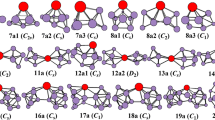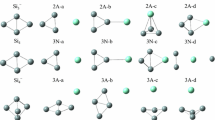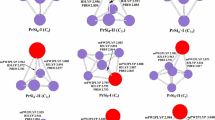Abstract
Silicon-based clusters have attracted particular attention because they are regard as building blocks for developing silicon-based nanomaterials. However, pure silicon clusters have low chemical stability owing to their dangling bonds. Doping with lanthanide atoms is a good way to form closed-shell of M@Sin clusters and alter their electronic and magnetic properties. Here, we systematically study the lanthanide element Pr doped neutral and anionic silicon clusters by using density functional theory. Extensive searches for ground-state structures of Sin+1λ and PrSinλ (n = 1–9, λ = 0, − 1) clusters were carried out based on the comparison between experimental photoelectron spectroscopy and simulated spectra. Furthermore, the calculated AEA values of our obtained structures show good agreement with the experimental values. Based on averaged binding energies, fragmentation energies and HOMO–LUMO gaps, their relative stabilities were analyzed. Furthermore, the patterns of HOMOs for the most stable isomers were investigated to gain insight into the nature of bonding. The results show that some σ-type and few π-type bonds are formed among Si and Pr atoms. To achieve a insight into localization of charge and charge-transfer information, the Mulliken population are analyzed and discussed.






Similar content being viewed by others
References
K. Tomioka, M. Yoshimura, and T. Fukui (2012). A III-V nanowire channel on silicon for high-performance vertical transistors. Nature. 488, 189–192.
B. Roche, R.-P. Riwar, B. Voisin, E. Dupont-Ferrier, R. Wacquez, M. Vinet, M. Sanquer, J. Splettstoesser, and X. Jehl (2013). A two-atom electron pump. Nat. Commun. 4, 1581.
Y. Chen, Y. Liu, S. Li, and J. Yang (2019). Theoretical study on the growth behavior and photoelectron spectroscopy of lanthanum-doped silicon clusters LaSin0/−(n = 6–20). J. Clust. Sci. 30, 789–796.
Y. Feng, J. Yang, and Y. Liu (2016). Study on the structures and properties of praseodymium-doped silicon clusters PrSin (n=3-9) and their anions with density functional schemes. Theor. Chem. Acc. 135, 258.
T. M. Fu, X. J. Duan, Z. Jiang, X. C. Dai, P. Xie, Z. G. Cheng, and C. M. Lieber (2014). Sub-10-nm intracellular bioelectronic probes from nanowire–nanotube heterostructures. Proc. Natl. Acad. Sci. USA 111, 1259–1264.
K. Koyasu, J. Atobe, S. Furuse, and A. Nakajima (2008). Anion photoelectron spectroscopy of transition metal- and lanthanide metal-silicon clusters: MSin− (n = 6–20). J. Chem. Phys. 129, 214301.
A. Grubisic, H. P. Wang, Y. J. Ko, and K. H. Bowen (2008). Photoelectron spectroscopy of europium-silicon clusters anions, EuSin− (3 ≤ n ≤ 17). J. Chem. Phys. 129, 054302.
C. G. Li, J. H. Gao, J. Zhang, W. T. Song, S. Q. Liu, S. Z. Gao, B. Z. Ren, and Y. F. Hu (2018). Structures, stabilities and electronic properties of boron-doped silicon clusters B3Sin (n=1–17) and their anions. Mol. Phys. 117, 1–13.
Y. Zhang, J. Yang, and L. Cheng (2018). Probing structure, thermochemistry, electron affinity and magnetic moment of erbium-doped silicon clusters ErSin (n = 3–10) and their anions with density functional theory. J. Clust. Sci. 29, 301–311.
T. D. Hang, H. M. Hung, and M. T. Nguyen (2016). Structural assignment, and electronic and magnetic properties of lanthanide metal doped silicon heptamers Si7M0/−with M = Pr, Gd and Ho. Phys. Chem. Chem. Phys. 18, 31054.
X. J. Li, Z. J. Yan, and S. N. Li (2016). The nature of structure and bonding between transition metal and mixed Si-Ge tetramers: a 20-electron superatom system. J. Comput. Chem. 37, 2316–2323.
I. Rata, A. A. Shvartsburg, M. Horoi, T. Frauenheim, K. W. M. Siu, and K. A. Jackson (2000). Single-parent evolution algorithm and the optimization of Si clusters. Phys. Rev. Lett. 85, 546–549.
V. T. Ngan, P. Gruene, P. Claes, E. Janssens, A. Fielicke, M. T. Nguyen, and P. Lievens (2010). Disparate effects of Cu and V on structures of exohedral transition metal-doped silicon clusters: a combined far-infrared spectroscopic and computational study. J. Am. Chem. Soc. 132, 15589–15602.
V. T. Ngan, E. Janssens, P. Claes, J. T. Lyon, A. Fielicke, M. T. Nguyen, and P. Lievens (2012). High magnetic moments in manganese-doped silicon clusters. Chem. Eur. J. 18, 15788–15793.
V. T. Ngan, K. Pierloot, and M. T. Nguyen (2013). Mn@Si14+: a singlet fullerene-like endohedrally doped silicon cluster. Phys. Chem. Chem. Phys. 15, 5493–5498.
P. Claes, V. T. Ngan, M. Haertelt, J. T. Lyon, A. Fielicke, M. T. Nguyen, P. Lievens, and E. Janssens (2013). The structures of neutral transition metal doped silicon clusters, SinX (n = 6–9; X = V, Mn). J. Chem. Phys. 138, 194301.
J. T. Lau, K. Hirsch, P. Klar, A. Langenberg, F. Lofink, R. Richter, J. Rittmann, M. Vogel, V. Zamudio-Bayer, T. Möller, and B. V. Issendorff (2009). X-ray spectroscopy reveals high symmetry and electronic shell structure of transition-metal-doped silicon clusters. Phys. Rev. A. 79, 053201.
X. Y. Kong, H. G. Xu, and W. Zheng (2012). Structures and magnetic properties of CrSin− (n= 3–12) clusters: photoelectron spectroscopy and density functional calculations. J. Chem. Phys. 137, 4307.
P. Shao, X. Y. Kuang, L. P. Ding, M. M. Zhong, and Z. H. Wang (2012). Density-functional theory study of structures, stabilities, and electronic properties of the Cu2-doped silicon clusters: comparison with pure silicon clusters. Phys. B. 407, 4379–4386.
W. Zheng, J. M. Nilles, D. Radisic, and K. H. Bowen (2005). Photoelectron spectroscopy of chromium-doped silicon cluster anions. J. Chem. Phys. 122, 071101.
S. N. Khanna, B. K. Rao, and P. Jena (2002). Magic numbers in metallo-inorganic clusters: chromium encapsulated in silicon cages. Phys. Rev. Lett. 89, 016803.
P. Shao, L. P. Ding, D.-B. Luo, and C. Lu (2019). Probing the structures, electronic and bonding properties of multidecker lanthanides: Neutral and anionic Lnn(COT)m (Ln = Ce, Nd, Eu, Ho and Yb; n, m = 1, 2) complexes. J. Mol. Graph. Model. 90, 226–234.
W. G. Sun, X. Y. Kuang, H. D. J. Keen, C. Lu, and A. Hermann (2020). Second group of high-pressure high-temperature lanthanide polyhydride superconductors. Phys. Rev. B 102, 144524.
M. Ohara, K. Miyajima, A. Pramann, A. Nakajima, and K. Kaya (2007). Geometric and electronic structures of terbium-silicon mixed clusters (TbSin; 6 ≤ n ≤ 16). J. Phys. Chem. A. 111, 10884.
V. Kumar, A. K. Singh, and Y. Kawazoe (2006). Charged and magnetic fullerenes of silicon by metal encapsulation: predictions from ab initio calculations. Phys. Rev. B. 74, 125411.
A. Grubisic, Y. J. Ko, H. Wang, and K. H. Bowen (2009). Photoelectron spectroscopy of lanthanide-silicon cluster anions LnSin− (3 ≤ n ≤ 13; Ln = Ho, Gd, Pr, Sm, Eu, Yb): prospect for magnetic silicon-based clusters. J. Am. Chem. Soc. 131, 10783–10790.
C. G. Li, L. J. Pan, P. Shao, L. P. Ding, H. T. Feng, D. B. Luo, and B. Liu (2015). Structures, stabilities, and electronic properties of the neutral and anionic SinSmλ (n = 1–9, λ = 0, -1) clusters: comparison with pure silicon clusters. Theor. Chem. Acc. 134, 1–11.
C. Lu, W. G. Gong, Q. Li, and C. F. Chen (2020). Elucidating stress-strain relations of ZrB12 from first-principles studies. J. Phys. Chem. Lett. 11, 9165–9170.
B. L. Chen, L. J. Conway, W. G. Sun, X. Y. Kuang, C. Lu, and A. Hermann (2021). Phase stability and superconductivity of lead hydrides at high pressure. Phys. Rev. B. 103, 035131.
C. Lu and C. F. Chen (2021). Indentation strengths of zirconium diboride: intrinsic versus extrinsic mechanisms. J. Phys. Chem. Lett. 12, 2848–2853.
M.J. Frisch, et al. (2009). Gaussian 09 (Revision C.01), Gaussian, Inc., Wallingford
A. D. Becke (1993). Density-functional thermochemistry. III. The role of exact exchange. J. Chem. Phys. 98, 5648–5652.
J. P. Perdew and Y. Wang (1992). Accurate and simple analytic representation of the electron-gas correlation energy. Phys. Rev. B: Condens. Matter. 45, 13244–13249.
C. Lee, W. Yang, and R. G. Parr (1988). Development of the Colle-Salvetti correlation-energy formula into a functional of the electron density. Phys. Rev. B. 37, 785–789.
G. D. Purvis and R. J. Bartlett (1982). A full coupled-cluster singles and doubles model: the inclusion of disconnected triples. J. Chem. Phys. 76, 1910–1918.
G. E. Scuseria, C. L. Janssen, and H. F. Schaefer (1988). An efficient reformulation of the closed-shell coupled cluster single and double excitation (CCSD) equations. J. Chem. Phys. 89, 7382–7387.
G. E. Scuseria and H. F. Schaefer (1989). An efficient reformulation of the closed-shell coupled cluster single and double excitation (CCSD) equations. J. Chem. Phys. 90, 3700–3703.
R. Krishnan, J. S. Binkley, R. Seeger, and J. A. Pople (1980). Self-consistent molecular orbital methods. XX. A basis set for correlated wave functions. J. Chem. Phys. 72, 650–654.
M. Dolg, H. Stoll, A. Savin, and H. Preuss (1989). Energy-adjusted pseudopotentials for the rare earth elements. Theor. Chim. Acta. 75, 173–194.
M. Dolg, H. Stoll, and H. Preuss (1989). Energy-adjusted ab initio pseudopotentials for the rare earth elements. J. Chem. Phys. 90, 1730–1734.
J. C. Yang, W. G. Xu, and W. S. Xiao (2005). The small silicon clusters Sin (n = 2–10) and their anions: structures, themochemistry, and electron affinities. J. Mol. Struct. Theochem. 719, 89–102.
C. Pouchan, D. Bégué, and D. Y. Zhang (2004). Between geometry, stability, and polarizability: density functional theory studies of silicon clusters Sin (n = 3–10). J. Chem. Phys. 121, 4628–4634.
K. Jackson, M. R. Pederson, D. Porezag, Z. Hajnal, and T. Frauenheim (1997). Density- functional-based predictions of Raman and IR spectra for small Si clusters. Phys. Rev. B. 55, 2549–2555.
N. Binggeli and J. R. Chelikowsky (1995). Photoemission spectra and structures of Si clusters at finite temperature. Phys. Rev. Lett. 75, 493–496.
O. Kostko, S. R. Leone, M. A. Duncan, and M. Ahmed (2010). Determination of ionization energies of small silicon clusters with vacuum ultraviolet radiation. J. Phys. Chem. A. 114, 3176–3181.
G. F. Zhao, J. M. Sun, Y. Z. Gu, and Y. X. Wang (2009). Density-functional study of structural, electronic, and magnetic properties of the EuSin (n = 1–13) clusters. J. Chem. Phys. 131, 114–312.
T. G. Liu, G. F. Zhao, and Y. X. Wang (2011). Structural, electronic and magnetic properties of GdSin (n = 1–17) clusters: a density functional study. Phys. Lett. A. 375, 1120–1127.
M. R. Nimlos, B. L. Harding, and G. B. Ellison (1987). The electronic states of Si2 and Si−2 as revealed by photoelectron spectroscopy. J. Chem. Phys. 87, 5116.
K. P. Huber and G. Herzberg, Molecular Spectra and Molecular Structure, Constants of Diatomic Molecules, vol. IV (Van Nostrand Reinhold, New York, 1979).
Y. R. Zhao, Y. Q. Xu, P. Chen, Y. Q. Yuan, Y. Qian, and Q. Li (2021). Structural and electronic properties of medium-sized beryllium doped magnesium BeMgn clusters and their anions. Results Phys. 26, 104341.
T. Lu and F. W. Chen (2012). Multiwfn: a multifunctional wavefunction analyzer. J. Comput. Chem. 33, 580–592.
T. Lu and F. W. Chen (2011). Calculation of molecular orbital composition. Acta. Chim. Sin. 69, 2393–2406.
Acknowledgements
This work was supported by the National Natural Science Foundation of China (Nos. 11804212), Youth Talent Invitation Scheme of Shaanxi Association for science and technology (Nos. 20180506 and 20190506) and the Shaanxi University of Science & Technology Key Research Grant (Nos. 2016BJ-01 and BJ15-07 ).
Author information
Authors and Affiliations
Corresponding author
Ethics declarations
Conflict of interest
The authors declare that they have no known competing financial interests or personal relationships which have or could be perceived to have influenced the work reported in this article.
Additional information
Publisher's Note
Springer Nature remains neutral with regard to jurisdictional claims in published maps and institutional affiliations.
Rights and permissions
About this article
Cite this article
Shao, P., Zhao, ZL., Zhang, H. et al. Probing the Structures, Stabilities and Electronic Properties of Neutral and Anionic PrSinλ (n = 1–9, λ = 0, − 1) Clusters: Comparison with Pure Silicon Clusters. J Clust Sci 33, 2723–2733 (2022). https://doi.org/10.1007/s10876-021-02188-0
Received:
Accepted:
Published:
Issue Date:
DOI: https://doi.org/10.1007/s10876-021-02188-0




